Nanchang CJ-6
Background
The development line of the CJ-6A can be traced back to the Russian Yak-18. The CJ-5 was a license built Yak-18 produced at the Nanchang Aircraft Factory from 1954 to 1958. With the introduction of jet powered aircraft to the PLAAF in the mid-1950's, the CJ-5 was considered inadequate, and a relacement was considered. The tricycle undercarriage Yak-18a met some, but not all the needs, and a in-house design was produced at the Shenyang aircraft factory. Bearing many similarities to the Yak-18a but a completely new design, the prototype CJ-6 was the result. This aircraft first flew on August 27, 1958, but proved disappointing. Replacement of the 145hp Russian M-11ER radial with the did not correct the problems and a redesign to correct the deficiencies resulted. The new prototype was flown on October 15, 1961, and testing proved successful. Production was approved in early 1962. A Chinese version of the Ivchenko AI-14P, the 260hp HS-6 was introduced in 1963. An uprated engine, the 285hp HS-6A was added in 1965, and the resulting aircraft were designated the CJ-6A. Between 1964 and 1966 an armed version was produced as the CJ-6B. Some reports indicate the CJ-6B utilised the 300hp HS-6D engine.
The CJ-6A is used by the PLAAF from ab-initio through to advanced training where trainees move onto the Shenyang JJ-5 (Mig 17 equivalent). Some CJ-6A have also been fitted with hardpoints for weapons training. Total production of all types is believed to have been over 3000 aircraft. An export version (designated BT-6) has been supplied to users including Albania, Bangladesh, Cambodia, North Korea, Tanzania, and Zambia.
New Zealand has seen a number of these aircraft imported as part of the burgeoning warbird scene. The first CJ-6A was imported into New Zealand in 1993, and a number have followed. They have been described as falling into the category of 'medium metal' falling somewhere between the DHC-1 Chipmunk and the T-6 Harvard. Often compared to the Yak-52 (which shares a similar ancestry), there appears to be a strong rivalry between the operators of the respective aircraft. The CJ-6A has the advantage of being a 'genuine' warbird, whereas the Yak-52 is a more aerobatic aircraft.
The currently operating aircraft are:
- ZK-CVI (c/n 3632001) was one of a batch of 18 CJ-6A imported into West Australia in 1995. Purchased by a syndicate in April 1996, the aircraft was dismantled and shipped to Nelson, arriving on May 31. It was built in 1980 (having data plates for April and May), and appears to have been accepted by the PLAAF on June 30, 1980. The aircraft was withdrawn from military service on April 8, 1992, having completed 3996 hours. The aircraft entered the New Zealand register on Jan 30, 1998 and is operated by a 9-member syndicate at Omaka, Blenheim.
- ZK-OII (c/n 1532004) was New Zealand's first CJ-6A. Imported from Beijing by a syndicate, the aircraft was assembled at AeroTech at Ardmore. The aircraft had only 1800 hours on the airframe, and the engine was only 186 hours from overhaul. Use was delayed by the need for CAA rule changes on the operation of ex-military aircraft, but the CJ-6A entered the New Zealand register on December 23, 1994. The aircraft is based at Ardmore. (illustrated below)
- ZK-STP (c/n 1232011) is a 1965 example and completed 2501hours in PLAAF service. The CJ-6A was imported along with ZK-WOK (below). The aircraft was a last minute purchase by Steve Petersen, as the aircraft was part of a cancelled order. The aircraft was assembled in New Zealand at AeroTech, Ardmore. It arrived at Omaka, Blenheim on November 28, 1996, having already gone on the New Zealand register on September 13. The aircraft was operated in its PLAAF livery until mid-1997. Then it was disassembled for control surface recovering, and a repaint. It returned to service in late 1997 in Chinese naval livery, and wearing the nose art 'Chia Doll. (illustrated below)
- ZK-WOK (c/n 2132042) was the Picton based Marlborough Warbird Syndicate's second attempt at landing a CJ-6A. The first factory overhauled aircraft had to be replaced after a tornado struck the factory building. The replacement aircraft wasa a 1963 model which had completed around 3000 hrs in military service. It arrived at Ardmore on October 3, 1996 and was assembled at AeroTech, Armore. It reached Omaka, Blenheim on November 25, 1996, and like ZK-STP had already gone on the New Zealand register on September 13. The aircraft was reregistered to a Blenheim syndicate on June 17, 1997. Originally in PLAAF livery, the aircraft was repainted into 'Albanian Desert Camouflage' during a 4 month refurbishment which was completed in early 1998. (illustrated below)
In addition there are at least three further aircraft currently being prepared for active use including 1832041 at Blenheim, 1432020 at Temuka, and another (c/n unknown) in Auckland.
Last Text Update:- 7 November, 2000
Last Picture Update:- 2 December, 2002
Technical Data
- Accommodation : 2
- Dimensions
- Span : 8.46m (27'9ft)
- Length : 10.18m (33'5ft)
- Height : 3.25m (10'8ft)
- Weight
- empty : 1095kg (2415lb)
- max : 1400kg (3090lb)
- Power Plant : 285hp Huosai Cj1a 9 cylinder radial
- Performance :
- max speed : 248km/h (217mph)
- max climb : 1248ft/min (380m/min)
- ceiling : 20,500ft (6248m)
- range : 685km (426miles)
Images
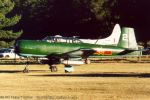
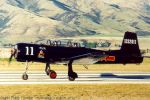

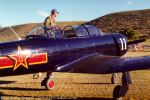
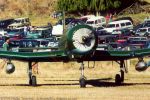
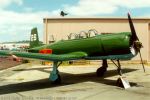
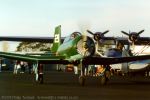
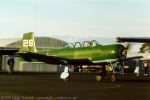
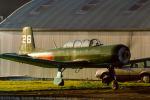
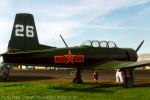
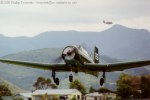
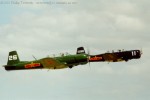
 © 1999-2002 Phillip Treweek, all rights reserved
© 1999-2002 Phillip Treweek, all rights reserved